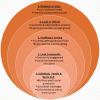The Meta Salud Diabetes Implementation Study: Qualitative Methods to Assess Integration of a Health Promotion Intervention Into Primary Care to Reduce CVD Risk Among an Underserved Population With Diabetes in Sonora, Mexico
- PMID: 31803710
- PMCID: PMC6874016
- DOI: 10.3389/fpubh.2019.00347
The Meta Salud Diabetes Implementation Study: Qualitative Methods to Assess Integration of a Health Promotion Intervention Into Primary Care to Reduce CVD Risk Among an Underserved Population With Diabetes in Sonora, Mexico
Abstract
Background: Within health promotion research, there is a need to assess strategies for integration and scale up in primary care settings. Hybrid interventions that combine clinical effectiveness trials with implementation studies can elicit important contextual information on facilitators and barriers to integration within a health care system. This article describes lessons learned in developing and implementing a qualitative study of a cluster-randomized controlled trial (RCT) to reduce cardiovascular disease (CVD) among people with diabetes in Sonora, Mexico, 2015-2019. Methods:The research team worked cooperatively with health center personnel from 12 Centers that implemented the intervention. The study used observations, stakeholder meetings, case studies, staff interviews and decision maker interviews to explore issues such as staff capacity, authority, workflow, space, and conflicting priorities, as well as patients' response to the program within the clinical context and their immediate social environments. Applying a multi-layered contextual framework, two members of the research team coded an initial sample of the data to establish inclusion criteria for each contextual factor. The full team finalized definitions and identified sub nodes for the final codebook. Results: Characteristics of management, staffing, and the local environment were identified as essential to integration and eventual adoption and scale up across the health system. Issues included absence of standardized training and capacity building in chronic disease and health promotion, inadequate medical supplies, a need for program monitoring and feedback, and lack of interdisciplinary support for center staff. Lack of institutional support stemming from a curative vs. preventive approach to care was a barrier for health promotion efforts. Evolving analysis, interpretation, and discussion resulted in modifications of flexible aspects of the intervention to realities of the health center environment. Conclusion: This study illustrates that a robust and comprehensive qualitative study of contextual factors across a social ecological spectrum is critical to elucidating factors that will promote future adoption and scale up of health promotion programs in primary care. Application of conceptual frameworks and health behavior theory facilitates identification of facilitators and barriers across contexts. Trial registration: www.ClinicalTrials.gov, identifier: NCT02804698 Registered on June 17, 2016.
Keywords: Mexico; cardiovascular disease; diabetes; health promotion; implementation science; primary care; qualitative methods.
Copyright © 2019 Ingram, Denman, Cornejo-Vucovich, Castro-Vasquez, Aceves, Ocejo, Zapien and Rosales.
Figures
References
-
- González-Pier E, Barraza-Lloréns M, Beyeler N, Jamison D, Knaul F, Lozano R, et al. . Mexico's path towards the sustainable development goal for health: an assessment of the feasibility of reducing premature mortality by 40% by 2030. Lancet Global Health. (2016) 4:e714–25. 10.1016/S2214-109X(16)30181-4 - DOI - PMC - PubMed
-
- Secretaría de Salud de México. Registro de Mortalidad: 2000–2015. (2018). Available online at: http://www.dgis.salud.gob.mx/contenidos/basesdedatos/da_defunciones_gobm... (accessed May 15, 2018).
-
- Secretaría de Salud de México. Declaratoria de Emergencia. (2016). Available online at: https://www.gob.mx/cms/uploads/attachment/file/265574/EE_4.pdf (accessed May 15, 2018).
Associated data
Grants and funding
LinkOut - more resources
Full Text Sources
Medical


